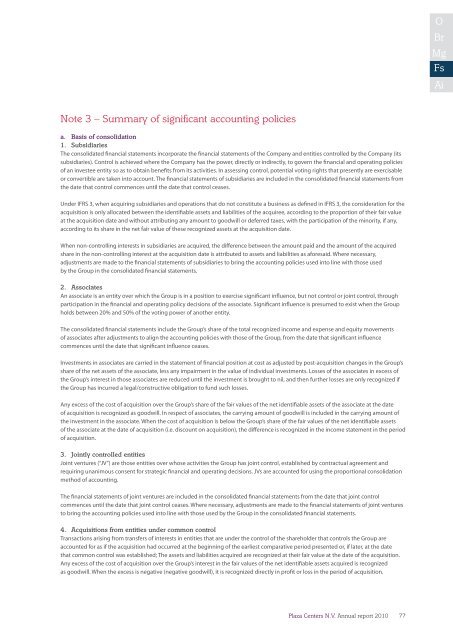Annual report 2010 - plazacenters
Annual report 2010 - plazacenters
Annual report 2010 - plazacenters
Create successful ePaper yourself
Turn your PDF publications into a flip-book with our unique Google optimized e-Paper software.
O<br />
Br<br />
Mg<br />
Fs<br />
Ai<br />
Note 3 – Summary of significant accounting policies<br />
a. Basis of consolidation<br />
1. Subsidiaries<br />
The consolidated financial statements incorporate the financial statements of the Company and entities controlled by the Company (its<br />
subsidiaries). Control is achieved where the Company has the power, directly or indirectly, to govern the financial and operating policies<br />
of an investee entity so as to obtain benefits from its activities. In assessing control, potential voting rights that presently are exercisable<br />
or convertible are taken into account. The financial statements of subsidiaries are included in the consolidated financial statements from<br />
the date that control commences until the date that control ceases.<br />
Under IFRS 3, when acquiring subsidiaries and operations that do not constitute a business as defined in IFRS 3, the consideration for the<br />
acquisition is only allocated between the identifiable assets and liabilities of the acquiree, according to the proportion of their fair value<br />
at the acquisition date and without attributing any amount to goodwill or deferred taxes, with the participation of the minority, if any,<br />
according to its share in the net fair value of these recognized assets at the acquisition date.<br />
When non-controlling interests in subsidiaries are acquired, the difference between the amount paid and the amount of the acquired<br />
share in the non-controlling interest at the acquisition date is attributed to assets and liabilities as aforesaid. Where necessary,<br />
adjustments are made to the financial statements of subsidiaries to bring the accounting policies used into line with those used<br />
by the Group in the consolidated financial statements.<br />
2. Associates<br />
An associate is an entity over which the Group is in a position to exercise significant influence, but not control or joint control, through<br />
participation in the financial and operating policy decisions of the associate. Significant influence is presumed to exist when the Group<br />
holds between 20% and 50% of the voting power of another entity.<br />
The consolidated financial statements include the Group’s share of the total recognized income and expense and equity movements<br />
of associates after adjustments to align the accounting policies with those of the Group, from the date that significant influence<br />
commences until the date that significant influence ceases.<br />
Investments in associates are carried in the statement of financial position at cost as adjusted by post-acquisition changes in the Group’s<br />
share of the net assets of the associate, less any impairment in the value of individual investments. Losses of the associates in excess of<br />
the Group’s interest in those associates are reduced until the investment is brought to nil, and then further losses are only recognized if<br />
the Group has incurred a legal/constructive obligation to fund such losses.<br />
Any excess of the cost of acquisition over the Group’s share of the fair values of the net identifiable assets of the associate at the date<br />
of acquisition is recognized as goodwill. In respect of associates, the carrying amount of goodwill is included in the carrying amount of<br />
the investment in the associate. When the cost of acquisition is below the Group’s share of the fair values of the net identifiable assets<br />
of the associate at the date of acquisition (i.e. discount on acquisition), the difference is recognized in the income statement in the period<br />
of acquisition.<br />
3. Jointly controlled entities<br />
Joint ventures (“JV”) are those entities over whose activities the Group has joint control, established by contractual agreement and<br />
requiring unanimous consent for strategic financial and operating decisions. JVs are accounted for using the proportional consolidation<br />
method of accounting.<br />
The financial statements of joint ventures are included in the consolidated financial statements from the date that joint control<br />
commences until the date that joint control ceases. Where necessary, adjustments are made to the financial statements of joint ventures<br />
to bring the accounting policies used into line with those used by the Group in the consolidated financial statements.<br />
4. Acquisitions from entities under common control<br />
Transactions arising from transfers of interests in entities that are under the control of the shareholder that controls the Group are<br />
accounted for as if the acquisition had occurred at the beginning of the earliest comparative period presented or, if later, at the date<br />
that common control was established; The assets and liabilities acquired are recognized at their fair value at the date of the acquisition.<br />
Any excess of the cost of acquisition over the Group’s interest in the fair values of the net identifiable assets acquired is recognized<br />
as goodwill. When the excess is negative (negative goodwill), it is recognized directly in profit or loss in the period of acquisition.<br />
<br />
Plaza Centers N.V. <strong>Annual</strong> <strong>report</strong> <strong>2010</strong>77








